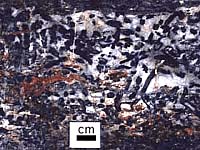 |
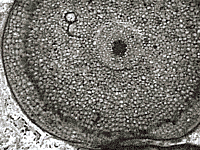 |

The Rhynie Chert beds in Aberdeenshire in the north of Scotland are important fossil sites that reveal much about the evolution of life from the Early Devonian, approximately 408-360 million years ago. At this time, the earth's geography was an aggregate mass of land in the Southern Hemisphere with smaller continents in the equatorial region. Europe resided near the equator, so the Rhynie Chert beds were in a tropical to subtropical climate and consisted mostly of flatlands and short-lived shallow pools of fresh water.
Rhynie fossils were preserved when mineral sediments settled around and on top of the organic matter and compressed them. Over time, the fossils were formed through silica replacement of the organic material. The silica deposits may have originated from hot springs and volcanic activity common in the Devonian and around the Rhynie fossil beds. The result is a preservation in chert, a kind of finely crystalline quartz, which occurs in veins throughout the rest of the surrounding rocks.
 |
 |
Preserved in rock : At left, a piece of the Rhynie chert; the black structures woven among the rock crystals are fossilized plant stems. At right, a thin section through a fossilized stem of Aglaophyton major, showing the exquisite detail of preservation; cell walls and tissue structure is preserved at the anatomical level.
The fossilized organisms preserved in the chert are studied using thin sections made through the rock in which they are embedded. Replacement of the plant tissues and other organic material is so fine that plant cells and fungal filaments are preserved in anatomical detail. One new method of thin section analysis uses light-transmitting microscope-aided stereophotomicrography to discern details in the form or structure of the organic matter. "The stereo image is created by juxtaposing two photographs of the same three-dimensional object, taken from slightly different angles, by moving either the camera or the object," (Winkelmann, 1995).
The kinds of organisms found in the Rhynie Chert include vascular plants, fungi, algae, and marine and terrestrial invertebrates. The Devonian was an exceptional time for the evolution of plants, and the Rhynie Chert provides fossil records of several genera from extinct groups of primitive plants. One of these, Aglaophyton, is often considered the earliest and simplest of vascular plants. More recent examination, however, has shown that the plant does not contain true vascular tissue but has conducting cells more like those found in some mosses. Like most of the other early plants, Aglaophyton had no leaves or roots. Additional fossils indicate that Aglaophyton grew in abundance with another somewhat more developed relative, Rhynia, as well as the bizarre Horneophyton, and the lycophyte Asteroxylon.
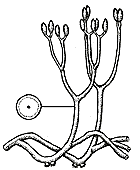 |
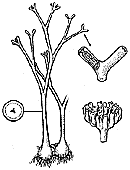 |
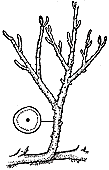 |
Early plants : At left, Aglaophyton major, one of the most structurally simple plants found in the Rhynie flora. The small circle to the left of the plant diagrams a cross-section throught the stem with false vascular tissue. At center, Horneophyton, a bizzare vascular plant; the sporangia were forked, and vascular tissue extended only partway up the stems. At right, Rhynia, one of the more complex plants found here, though like Aglaophyton and Horneophyton, it had no leaves or roots.
These groups of early vascular land plants have been discovered in excellent condition in specimens where silicification of the plants occurred while they were still alive and growing. Extremely minute detail has been preserved in some of these fossils, allowing a clear view of the fragile root-like rhizoids, the spores and reproductive structures, the vascular systems, gametophyte generations, and even the seasonal growth of the plants. Such discoveries are highly prized for allowing an insight into the development of the first vascular plants, especially in terms of their vascular transport system and the evolution of life histories.
Other significant discoveries from the fossils of the Rhynie Chert are the diverse fossils of fungi and record of their interactions with the surrounding plants. The relationship between the alga Palaeonitella, and the aquatic fungus Sorodiscus that invaded its cells, is one early example of parasitism found preserved in the fossil record. It is quite difficult to establish a parasitic or a symbiotic relationship in paleontology, but this alga's swollen cells where the fungi was present reflects a phenomenon very similar to that seen today. Detailed Rhynie Chert fossils of mycorrhizal fungi of the family Glomaceae have also been found in association with the early vascular plants, having been discovered in the plants' preserved stems. Fossils of tiny chytrids, simple fungi, also have been found in the tissue of Horneophyton and even in the spores of Aglaophyton. The discovery from the fossil record that there were plant-fungi relationships is important because it shows that by the Early Devonian complex interactions between terrestrial organisms were occurring.
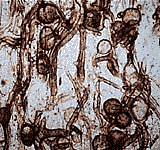 |
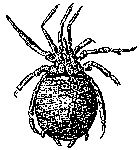 |
More than plants : On the left, a thin section through plant tissue preserved in the Rhynie chert reveals fungal filaments growing among the cells. On the right, Eophrynus, a trigonotarbid similar to those found at Rhynie, Scotland.
Other organisms found in the Rhynie Chert include marine and terrestrial invertebrates. Crustaceans of the order Lipostraca as well as trigonotarbids (spider relatives) that might be some of the earliest members of their groups have been discovered. The Lipostraca specimen, Lepidocaris rhyniensis, was preserved so well due to its hard outerbody shell that the fine details of its limbs can be discerned. This is possibly one of the best-preserved crustacean fossils ever found.
Principal figures in Devonian Rhynie Chert field research are Robert Kidston and Henry Lang. Working in the 1920s, they were the first to describe many of the algae, fungi, and plants from the Devonian period. Kidston, in his later studies of the Rhynie fossils was mainly concerned with the organisms' morphology (the structure or body formations of organisms). Kidston and Lang's work is still considered to be a standard for the Rhynie Chert, though many other scientists have also made contributions, and continue to excavate and study this rich locality.
For more pictures and explanatory text, read about the Rhynie Flora at UCMP's Virtual Paleobotany Lab.
Those interested in current work in the Rhynie chert should visit the Rhynie Chert Resource Page, featuring images of arthropod cuticle and links to related information. You definitely shouldn't miss Die Rhynie Chert Flora at the University of Münster. The page is in German, but the pictures and information are valuable; it is a part of the larger History of Paleozoic Forests site.


